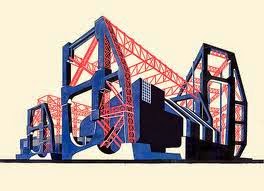The possibilities that infrastructure provides has the potential to bring back the machine aesthetic. In Allen’s article, he describes it as "a moment in which the technical and the aesthetic formed a unified whole." In a different way, it is the same discussion of form and function. Allen creates an interesting timeline driven by national and international events. The Cold War kept the "modernist dream of an integration of technology and aesthetics was no longer believable." Wartime economies created “spaces of production” that focused on efficiency. This period focused on material concrete processes and the passage of information. He then goes on to say "a postmodern culture of abstract signs and surfaces without depth." It also includes a rediscovery and reappropriation of the past (which often leads to loss in depth). As Allen explains, this means that architecture moves from being driven by organization to surfaces.
Monday, December 15, 2014
THE RESURGENCE OF INFRASTRUCTURE
The possibilities that infrastructure provides has the potential to bring back the machine aesthetic. In Allen’s article, he describes it as "a moment in which the technical and the aesthetic formed a unified whole." In a different way, it is the same discussion of form and function. Allen creates an interesting timeline driven by national and international events. The Cold War kept the "modernist dream of an integration of technology and aesthetics was no longer believable." Wartime economies created “spaces of production” that focused on efficiency. This period focused on material concrete processes and the passage of information. He then goes on to say "a postmodern culture of abstract signs and surfaces without depth." It also includes a rediscovery and reappropriation of the past (which often leads to loss in depth). As Allen explains, this means that architecture moves from being driven by organization to surfaces.
Subscribe to:
Post Comments (Atom)

No comments:
Post a Comment
Note: Only a member of this blog may post a comment.